Review GSM phone Pantech PG-3000
Package:
- Handset
- Battery
- Charger
- Manual

The company of Pantech is the third greatest Korean mobile phone manufacturer. It attempts to draw attention to its production in Europe by putting out original models of GSM phones - take for instance GI100
which is the first device to have a biometric protection system and is for sale now. The model PG-300 is revolutionary not so much for the user as for the company, since this is it's the first slider with a 1.3-megapixel camera.

The design stands out and cannot be confused with Samsung products. The phone body is rectangular and the edges are smoothed over, hence the device looks more strict. The upper and lower parts are silvery and the middle is taupe, which makes it look like a sandwich. The quality of the plastic and assembling is quite good. The larger part of the upper panel is seamy and this makes the phone more attractive. Opinions about PG-300's design differ: some relish the phone owing to its severe appearance and others dislike exactly that austerity. Anyway, we can definitely say the device will sell.
The phone dimensions are 87x42x22 mm and the weight equals 100 g. The handset may be compared to Samsung D500 (93.5x45.7x23.5 mm, 99 g) in these parameters. The phone fits a hand very well even though there is little imbalance of weight while the device is open and this fact is observed when the handset lies on a plane surface (the upper part outweighs). Still this drawback has no effect on usability.




The slider mechanism has an auto finishing function. There is a thrust under the screen for easy opening. The guiding rails are made of metal and this advance the construction reliability. Our sample has a small horizontal backlash between the two halves and on account of that the slider move was very smooth and there were no such an irritating click as with D500. The move is more likely to resemble that of Samsung
E850 - fluent and smooth. Several times while opening the phone's upper part did not reach 4-5 mm to the stop and I had to do it myself. Despite some shortcomings, I cannot say they must spoil before they spin and the small defects will have been remedied till the device enters the market.
At the top of the front surface there is a loudspeaker placed to the right and hence you will have to get accustomed to this location while talking. A 1.8" TFT screen with the resolution of 128x160 pixels showing 260K colors occupies the most part. The screen has its brightness and contrast artificially raised and so the image looks unnatural. Compared to the Samsung D500's screen, it gains in brightness and loses in image accuracy and naturalness.



Under the screen there is a large 4D navi button with an integrated OK which is very handy. A system indicator encircles the navi button and has three colours - red, blue, and purple.

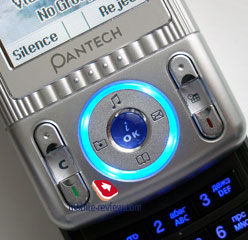

On the navi button's sides there are vertical rows of three keys. The upper ones are softkeys, the middle keys (of transparent plastic) are a cancel key (on the left) and an access to organizer (on the right) and the lower are an answer and a reject keys. Due to the small size and close allocation of the keys, they require getting used to and at first, mistypes cannot be avoided.
The number keypad is available only when the handset is opened. The keys are disposed in horizontal rows (three in each) densely. The keys are modest in size and while pressing a button one is unlikely to touch an adjacent key. The blue backlight is evenly distributed over the whole keypad and therefore characters (both Latin and Cyrillic) are read well.

The left side surface has a headset connector shielded with a rubber shutter fixed to the body, a volume button, and a full-blown IrDA gap. There is merely a camera key on the right side surface.

The bottom traditionally has an interface connector shielded with a rubber shutter fixed to the body. The shutter is made of very hard rubber and as a result after the device has been charging for a night, in the morning the shutter did not fix in the original state. A user will have to cut it off (there is not another evident way out) since it does not look so good if a handset has something hanging down. The top has only a strap hole.
There is a mirror (for self-portrait), a camera lens, and a flash on the back of the upper cover. The lens is protected from dust and scratches when the device is closed.

A battery that also serves as a back wall occupies almost the whole back surface and it is 1-1.5 mm higher than the body. At the top there is a finger hollow. The battery clamp is reliable with no backlash. The battery supplied with the phone is an 850mAh Li-Ion. According to the manufacturer, the device is able to work for up to 200 hours in standby mode and up to 250 minutes in talk mode. In the condition of Moscow MTS network the handset worked for 2 days with 30 minutes of calls a day and up to 15 minutes of using other functions. If the camera is frequently used, the battery life reduces to 1-1.5 days. Full charge takes an hour approximately.

Menu
The main menu is represented in two variants. In the first case, three rows of three icons are shown, the selected item is highlighted and its title is reprinted above. In the second case, the screen shows one big icon with an explaining inscription and the item number below as well as small icons of the further items. Both appearances are of interest and, after a variant is chosen, the submenu coloring changes as well. The former suggests blue and the latter is of purple. The submenu is represented as vertical lists and has a quick navigation using number sequences. Some sub-items do not require entering, for the information of actions that could be taken shows at the foot of the screen and a horizontal press of the navi button selects an action.
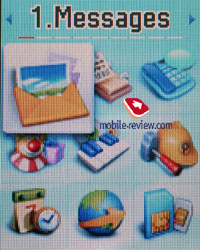
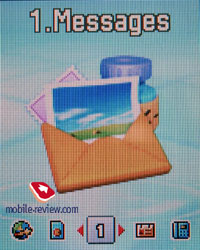

The menu localisation is carried out at a mean level. Some titles are abbreviated and this is not acceptable. By the time of this review the, next version of the model, which has some localisation drawbacks corrected, will be out.
The phone has 8.4Mb of embedded memory that is dynamically distributed among applications.
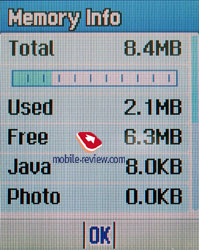
Phone book. Phone book. The device holds up to 800 numbers. Entries are shown both separately from the phone memory or SIM-card and altogether. Each entry can have name, up to four numbers, and e-mail. Moreover you may assign a ring tone, a photo or a video to show at a call and put into one of ten caller groups. One can either use 4 existed groups or create a new one. Any group can have a name of up to 19 characters and a ring tone.
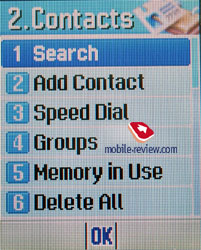
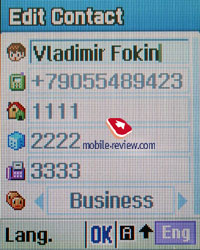
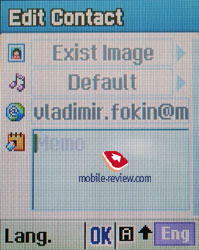

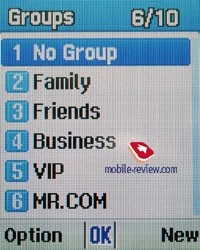
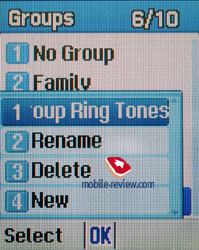
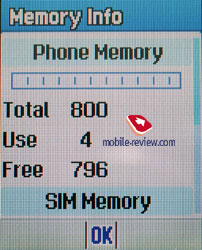
There is a speed dialling of up to 9 numbers. A search of the phone book can be made by name, group or photo (video) as well as speed dialling number.
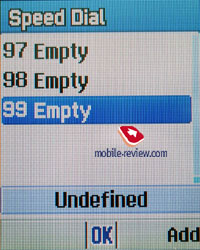
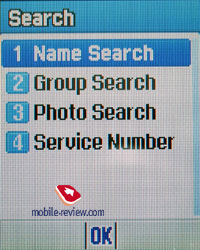

At an incoming call, photos or videos assigned to callers show full screen and the name (if the number is contained in the phone book) and group title.

Messages. The device supports EMS standard and hence has a set of small images, animations, and melodies to add to the message body. There are preset text templates and an opportunity of creating own ones. The MMS editor is clear and simple.
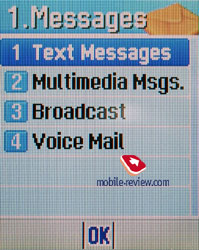
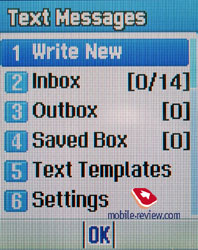
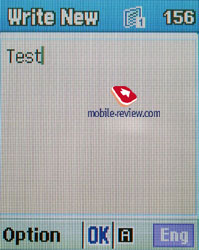
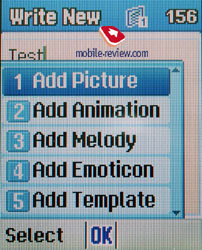
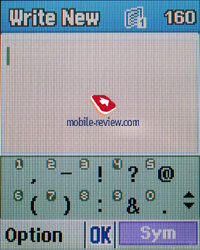




A mere three melodies are available for message alerts and a repetition could be set for every two or five minutes.
Call list. Here you can view the information of dialled, received and missed calls. The equal numbers do not combine and show one by one.
Profiles. There is an offer of 5 adjustable call profiles.

Settings. This holds everything concerned with the phone, network, screen, sound, and other settings. One of preset images or animations and any image uploaded by the user or taken with the camera can be assigned as wallpaper. You may also choose a screensaver in standby mode. One of the offered variants of clock and calendar displaying is to be chosen for the main screen. The backlight time runs from 5 seconds to 10 minutes.
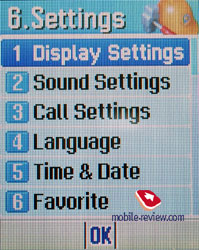

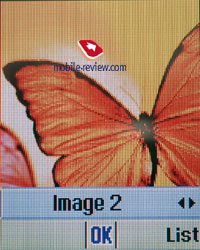

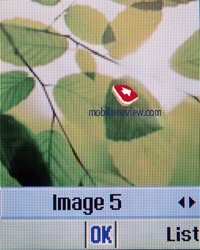
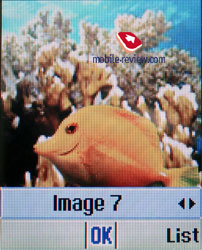

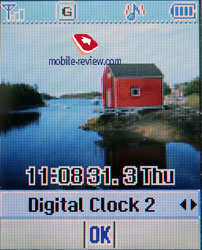
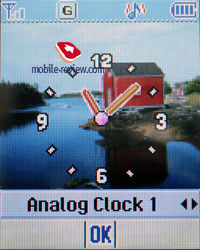
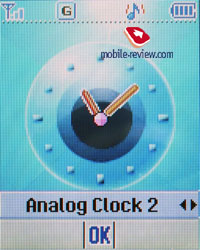
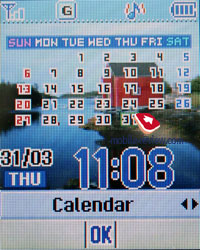
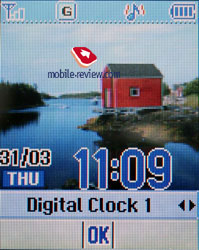


The sound settings contain a call type - vibra, signal, progressive signal, vibra and signal together and first vibra and then signal. Various signals could be assigned to almost every action.

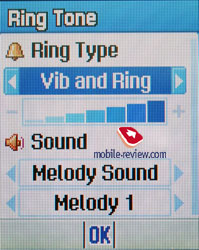
You can upload your pictures and MP3 melodies to the device, yet there is a restriction on the capacity of a transmitting object - 300Kb.
There is also a menu 'Favourites' - this is the user's own menu for a quick access to frequently used functions. In standby mode you get here by pressing left on the navi pad.

Organizer. Alarm clock. You may set 5 independent alarms and each of them can activate once, daily or from Monday till Friday (till Saturday).
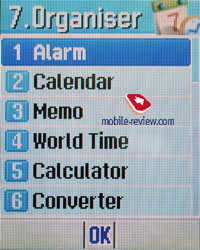
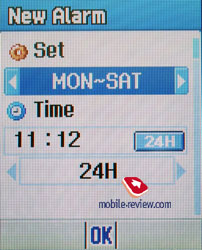
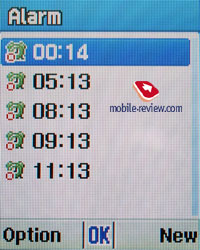
Calendar. A view of either a whole month or the all event list is possible. An event has a mark (birthday, meeting, trip etc.), time, a text note, an alert or an activation time (in time or in a period from 15 minutes to 1 day before the event). You can also determine an event repetition - once, every month or every year. There is a limitation of 50 messages in all.
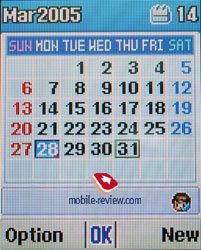
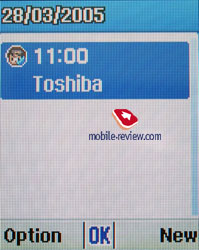

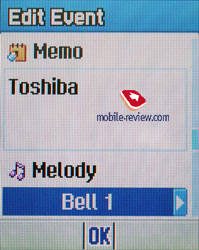
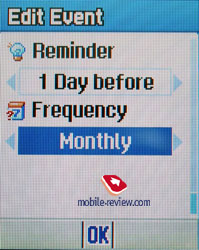
Notebook. Creating text notes of up to 255 characters is possible.

Also, the device has a world time, a simple calculator, a unit convector, a stopwatch (up to 5 intermediate values), and a timer.
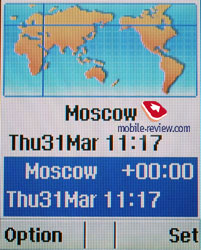
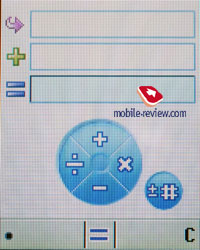
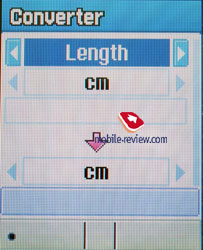


Fun and Tools. Camera. The handset supports several resolutions - SXGA (1280x1024), VGA (640x480), QVGA (320x240), LCD (128x160). The quality is also to be determined - Fine, Normal, Low. Taking a series of 4 to 15 pictures in a certain period is possible. The flash can be in automatic operation mode, online or off mode. The flash is not worth anything special to say since it is rather a bright torch and is little help while taking photos in the dark. Pictures are saved to the default folder or you can create your own folders. Photos of high resolution and quality take a long time to save (15-20 seconds approximately).
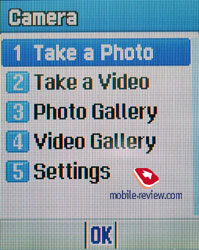
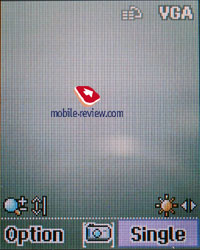
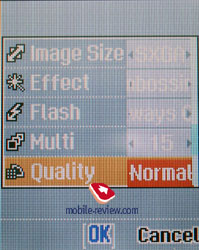
The menu is possible by pressing the left softkey. The timer is set up to 5 seconds. Moreover there are 10 accessible frames to put on a picture.
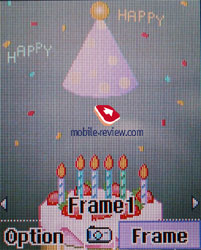
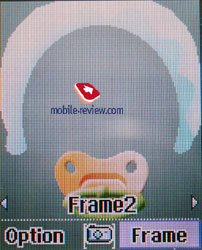

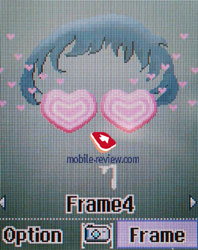
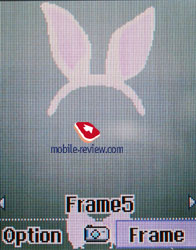
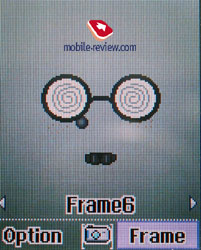

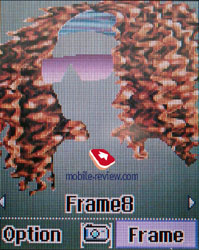
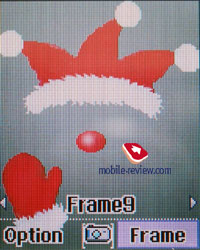
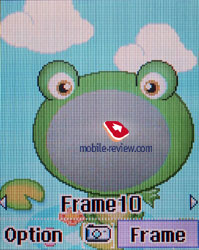
A left or right press of the navi button adjusts brightness and an up or down press activates the 10x digital zoom.
Sample
zoom work in a file – 747 KB, ZIP>>>
The device has some effects - Warm, Sepia, Antique, Cool, Moonlight, Fog, Negative, Grayscale, Embossia.
See effects in an archive, ZIP, 2.77 MB >>>
Taken photos are of good quality, yet have some natural colors distorted a bit and the image becomes darker. The picture edges get out of focus and are blurred somewhat. The picture quality stands between those of Sony Ericsson S700 and
Samsung D500. It does not reach the quality of S700 but is a little better than D500 one. So I suggest viewing a picture series taken by these three devices.
Sample
photo outdoors, 1280x1024, Fine, 323 KB, JPEG
Sony
Ericsson S700; Samsung
D500
Sample
photo outdoors, 1280x1024, Fine, 304 KB, JPEG
Sony
Ericsson S700; Samsung
D500
Sample
photo outdoors, 1280x1024, Fine, 330 KB, JPEG
Sony
Ericsson S700; Samsung
D500
Sample
photo outdoors, 1280x1024, Fine, 246 KB, JPEG
Sony
Ericsson S700; Samsung
D500
Sample
photo outdoors, 1280x1024, Fine, 338 KB, JPEG
Sample
photo outdoors, 1280x1024, Fine, 288 KB, JPEG
Sample
photo outdoors, 1280x1024, Fine, 346 KB, JPEG
Indoors in daylight or candlelight as well as outdoors in overcast weather the picture quality decreases.
Sample
photo outdoors, 1280x1024, Fine, 244 KB, JPEG
Sample
photo indoors, 1280x1024, Fine, 283 KB, JPEG
Sample
photo indoors, 1280x1024, Fine, 159 KB, JPEG
Any picture can be transmitted to a PC using IrDA.
The device permits recording video sound-films in MJPEG format at the resolution of 128x160 pixels. A film of about 9 seconds takes approximately 265Kb. When played back, they are played at full screen with no breaks. Video films could not be transferred to a PC or sent by MMS as they can only serve as wallpaper or be assigned to phone book entries.

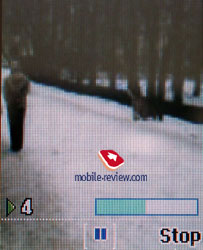
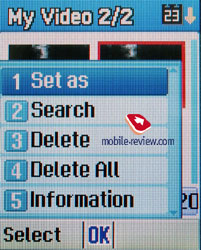

Media gallery. This contains folders of photos, videos, images and sounds. Here you may also see the information about free and used memory.
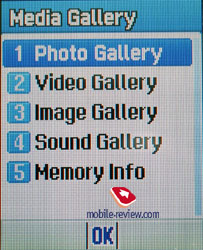
Games. The device has one preinstalled logic game called Smokey.

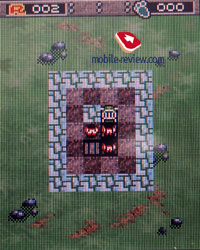
Java. The handset supports MIDP 2.0. There is a preset arcade game called Aqua. Installing other ones has run with no trouble.
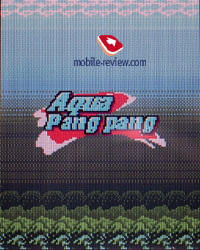
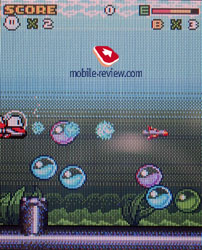
Answerback drum. The device has a preset answerback drum that you can adjust to you when recording a hello message or selecting a preinstalled one (meeting, driving etc.) and determining an activating time in a period from 3 to 20 seconds. This function will attract subscribers whose tariff scale provides free incoming calls in order to save on voice mail. This function can be put to "Favourites' for easy access to it.

Voice notes. This allows creating voice records of up to 30 seconds.

Connections. This menu holds access to a WAP browser of 2.0 version and IrDA settings which have several modes - Internet connections, PC synchronization, object transmission.
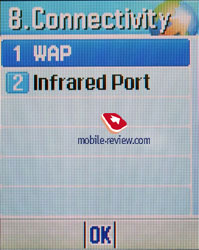

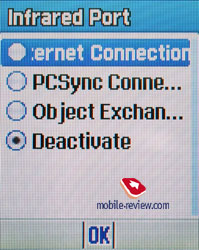
Impressions
The device is quite good in connection quality even though there were some moments when the caller complained that the voice sounded muffled. The quality of 64-voice polyphony is rather good and the alert volume suffices so that a call cannot but be heard. The vibracall is modest in power and sometimes you could miss it.
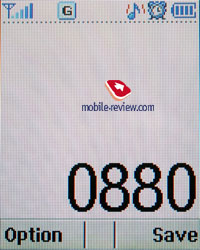

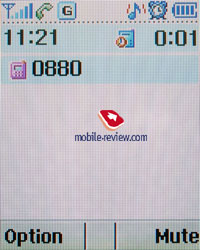
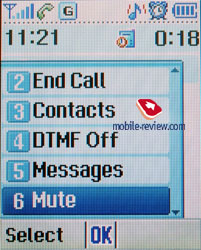
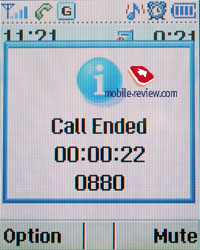
In the first place the handset will attract with the design that draws attention and does not resemble that of rival products. The menu realisation is handy and one will soon get accustomed to it. The preset 1.3MP camera has done justice to itself as it permits taking pictures of adequate quality. The presence of Java and assigning MP3's to ring tones form an advantage.
Now I will tell of disadvantages. Firstly, the slider mechanism is not elaborated, but this defect is likely to be remedied. Secondly, the soft key realisation of the front panel is not so handy. The long time of picture saving could not called a benefit. The internal memory capacity of 8.4Mb is not very big with the presence of a 1.3MP camera, assigning MP3's to ring tones and installing Java-applications. Video films of MJPEG could be used only on the phone and not be transmitted anywhere.
The device has proved interesting and it is to rival Samsung products. Pantech PG-3000 is schemed to be on sale in May 2005, though an advertising campaign has already started. By the time the device enters the market, it will cost 550 USD, which is quite expensive.
Melody samples (mp3, 324 KB)
Vladimir Fokin (vladimir.fokin@mobile-review.com)
Translated by Maria Mitina (maria.mitina@mobile-review.com)
Published — 17 April 2005
Have something to add?! Write us... eldar@mobile-review.com
|







































































































